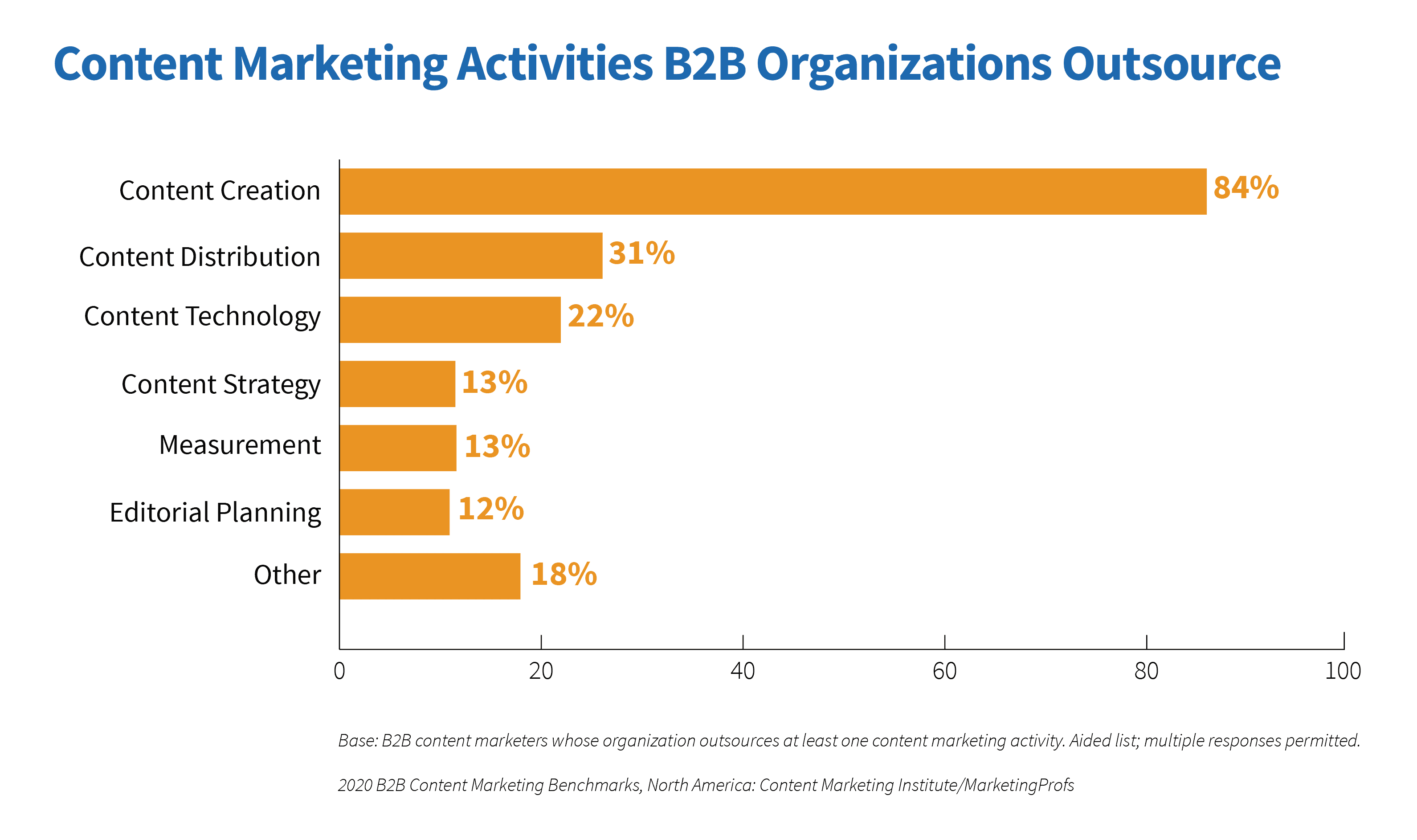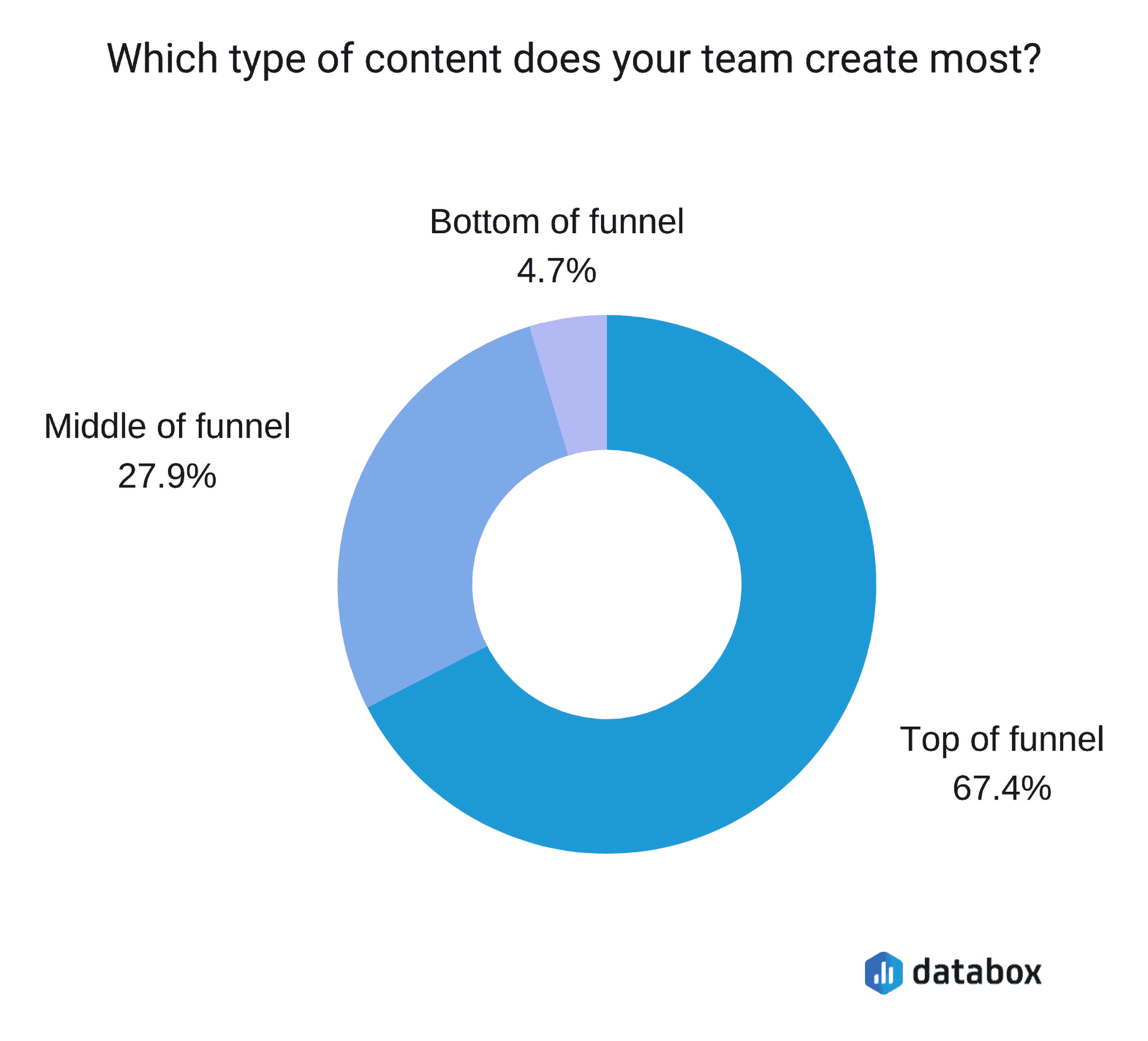30 Crucial B2B Marketing Statistics
Written by Brian Dean

In this post, you’ll find 25+ B2B marketing statistics to have on your radar for 2024.
Unlike most stats posts, all of these stats are 100% up-to-date. In fact, I go back and update this page regularly.
So if you’re looking for B2B marketing stats that are relevant today, you’ll love this list.
Click for a specific section:
- B2B Marketing Teams
- B2B Marketing Budgets
- B2B Lead Generation Statistics
- B2B Content Marketing Statistics
- B2B Video Marketing Statistics
- B2B SEO Statistics
- B2B Email Marketing Statistics
- B2B Social Media Statistics
- B2B Marketing Analytics Statistics
B2B Marketing Teams
41% of B2B businesses conduct their marketing activities in-house (Statista)
There are a million things that go into full-scale B2B marketing strategy: Strategy. Planning. Tracking results. And more.
Yet almost 60% of B2B brands don’t do all of that stuff in-house.
Instead, the vast majority of B2B companies get help with activities like keyword research, content writing, and ad management. Some outsource the work to agencies. Others hire freelancers with specific expertise. Either way, nearly 60% of B2B brands get some form of help with their marketing from external sources. This means that just over 40% actually say they handle the end-to-end of their B2B marketing strategy in-house.
Half of B2B marketing teams outsource at least one content marketing activity (CMI, CMI)
Speaking of outsourcing, Content Marketing Institute found that half of all B2B marketing teams outsource at least one of their content marketing activities.
Among large companies (with over 1,000 employees), B2B organizations outsource 75% of their content marketing activities, which decreases to 54% and 37% share among medium (100-999 employees) and small companies (under 100 employees), respectively.
And that 84% of those who outsource cite content creation as the activity they get the most help with.
Distributing content comes in at a distant second (31%).
Other tasks (like content planning, measurement, or research) seem to be reserved almost exclusively for in-house marketers.

B2B Marketing Budgets
On average, B2B organizations allocate 9.7% of their total budget to marketing (CMO Survey)
Most B2B businesses would agree: marketing is SUPER important for the company’s success.
Like with B2C, a successful marketing campaign can help get your brand in front of more people. Turn those people into leads. And ultimately get more sales.
Yet it doesn’t seem like most marketing budgets are conscious of that. B2B product organizations spend 9.7% of their overall budget on marketing, while for B2B services organizations that’s as little as 7.2%.
To put it in perspective, B2C product and services organizations spend 18.83% and 10.6% of their overall budgets on marketing, respectively.
45% of B2B companies plan on increasing their content marketing spend within the next 12 months (CMI)
B2B content marketing is nothing new. So you might expect that companies would funnel some of their content marketing budget towards new strategies, like influencer marketing.
But that’s clearly not the case.
Nearly half of B2B organizations said they’re planning to boost their content budget in the next year. Just 6% of respondents plan to slow down their spending.
Which goes to show that content marketing still has a high potential ROI in the B2B world.
69% of B2B marketers plan to increase their investment in video marketing in 2024 (CMI)
When it comes to B2B marketing budget increases, 69% of marketers plan to increase spending on video, followed by thought leadership content (53%), in-person events (47%) and paid advertising (43%).
| Area | Share of B2B marketers who plan budget increases |
|---|---|
| Video | 69% |
| Thought leadership content | 53% |
| In-person events | 47% |
| Paid advertising | 43% |
| Online community building | 33% |
| Webinars | 33% |
| Audio content | 25% |
| Digital events | 21% |
| Hybrid events | 11% |
Spending on digital advertising is set to reach $645.8 billion by 2024 (eMarketer)
Speaking of budgets, eMarketer predicts that worldwide spending on digital advertising will reach record-breaking levels by next year.
Needless to say, a good chunk of that will be spent on B2B ad campaigns, like LinkedIn ads, conference sponsorships, and Google Ads.
B2B Lead Generation Statistics
According to 84% of B2B marketers, content marketing helped in building brand awareness (CMI)
It’s easy to think that B2B content should be boring and “professional”.
But the truth is: B2B buyers are still human.
Yes, they want tangible solutions to their business problems. But that doesn’t mean that they want to read dry white papers. Or jump on a sales call after their first visit to your website.
Like any human being, reading content from a brand can help decision-makers know, like and trust you more.
As it turns out, top-of-the-funnel branded content isn’t the exception. It’s the rule: half of all content being put out by B2Bs is designed to engage potential customers.
Like in the B2C world, people at work watch YouTube videos, read blogs and engage in communities.
73% of B2B marketers use lead conversions as a performance metric (CMI)
Content marketing ROI can be tricky to track. But it’s not impossible.
Especially if your sales and marketing teams are on the same page.
Sure, your marketing team can send thousands of visitors to your site. But if those marketers don’t know what an ideal customer looks like. Or why they’ll ultimately convert. Traffic could stay exactly that: just traffic.
Marketing teams need to know exactly what their target B2B buyer looks like. And how to create content that drives that person to sign up as a lead. Both of which are best learned from sales teams on the front lines.
The average MQL to SQL conversion rate is 13% (Implisit)
Just 13% of the people marketing teams would consider a “lead” something a sales rep can work on.
Here’s what that looks like in practice: 10,000 people land on your website. Marketers consider 1,000 of those to fit the ideal customer profile. Yet when sales reps dig through and find B2B accounts to prioritize, they find just 130 actually fit the mold of a paying customer.
The MQL to SQL for leads found through webinars is 17.8%. Which is a little better. But still pretty bad.
Either way, the misalignment between sales and marketing could mean you’re driving traffic to your B2B website that isn’t ever going to pay off.
B2B Content Marketing Statistics
Most marketers publish new content several times weekly (Databox)
There’s no doubt that it’s not easy to get customers to see the content that your B2B brand publishes. Which is why it’s important to put out a decent amount of content. That way, the odds are in your favor.
In fact, most marketers are publishing new content in the form of videos, blog posts, or podcast episodes on a weekly basis. And many publish a new piece of content every single day.
It takes 3 hours and 51 minutes to write a blog post (Orbit Media)
“Writing a blog post” isn’t as easy as it used to be. On average, it takes almost four hours to write a single blog post. That’s an extra 23 minutes from just five years ago.
And in many cases, B2B content takes longer to write. There’s usually more research. More data. And more polish that needs to be done.
Dedicating nearly four hours to a single blog post is no joke. Especially for busy B2B marketing teams. That’s likely why most B2B companies outsource at least one content marketing activity. And why “content creation” is first on that list.

Content ranking on page 1 of Google has 1,447 words, on average (Backlinko)
This is one of the reasons that writing a blog post takes longer than it used to. Blog content used to be relatively short (400 words or so).
Today, most of the posts that B2B blogs publish are 1,000+ word monsters. And this is partly because long-form content seems to be good for SEO.
Specifically, we found that the average first-page results come in at almost 1,500 words long. Longer content means you can cover a topic comprehensively.
Comprehensive content is exactly the type of content that busy decision makers want to read. And, according to this analysis, the type of content that Google wants to rank.
67% of B2B content teams say top-of-funnel content is the type of content they create most (Databox)
B2B content converts best when someone is SUPER close to signing up as a lead.
That said: there are usually only a handful of keywords in your niche that fall under that category. And they’re probably super competitive.
Enter: top-of-the-funnel content.
Research shows that 67% of B2B content teams create top-of-funnel content the most often. Likely because that’s where most of the eyeballs are.
28% say they create content for people in the middle of the funnel (someone ready to buy but needs a nudge).
Just 5% focus their attention on B2B buyers moments away from buying.

65% of B2B buyers say they find short-term content (blog posts, infographics) most appealing to them (Demand Gen Report)
There’s a reason why B2B content marketing is a hugely popular marketing strategy.
Content is a great way to drive traffic to B2B sites. And can drive leads into your sales funnel.
Over 6 in 10 B2B buyers say they are specifically interested in short-form content assets and half would like to engage with long-form content.
| Content Format | Share of B2B Buyers Who Find It Most Appealing |
|---|---|
| Short-form content (infographics and blog posts) | 65% |
| Webinars and digital events | 52% |
| Long-form content (white papers, e-books) | 50% |
| Interactive multimedia content | 42% |
| Case studies/user-generated content/product reviews | 42% |
| Audio and video content | 40% |
| Third-party-validated resources (sponsored reports) | 33% |
| Serial content (podcasts, industry newsletters) | 29% |
| Thought leadership from in-person events | 23% |
B2B Video Marketing Statistics
More than half of tech buyers think video is the most useful form of content (Isoline Comms)
When you think of “content,” most people in B2B think of text-based content, like blog posts, reports and case studies.
That said, B2B buyers don’t necessarily want to consume text content. In fact, over half of B2B tech buyers voted video content as the most useful form of content.
Around 9 in 10 B2B buyers watched a video to learn about the company’s products or services in the past 3 months (Brightcove)
88% of B2B buyers say they spend time watching video content to learn about products or services in the past 3 months.
Whether that’s video hosting on a website. Or on YouTube. A surprising amount of content consumption in B2B is video-based.
B2B SEO Statistics
The majority (66%) of B2B buyers in the US discover products from internet search results (Statista)
It’s interesting to note that most B2B buyers use the internet to gather information about products or services they’re thinking about buying. Not reading industry publications. Or attending trade shows.
| Channel | Share of B2B Buyers in the US Who Use It To Discover Products |
|---|---|
| Internet search results | 66% |
| Online marketplaces | 50% |
| Product catalog | 43% |
| Industry associations | 42% |
| Online adverts | 35% |
| Referrals | 33% |
| Industry publications | 29% |
| Physical advertising | 24% |
| Trade shows | 23% |
| Social media advertising | 23% |
| TV advertising | 14% |
29% of Google users only visit one page from the search results (Backlinko)
When you type something in Google, how many results do you tend to click on? Most B2B buyers would have a simple response: “One.”
B2B buyers don’t typically hop around different websites to find what they’re looking for. Remember: they’re busy people looking for a quick solution to their problem. Which means they usually land on one page. Find their solution. And move on to the next thing.
B2B Email Marketing Statistics
Email newsletters as a distribution channel produce best results for B2B marketers, according to 39% of respondents (Content Marketing Institute)
The people who’ve subscribed to your email list are your most loyal fans. And according to this research, the leads closest to making a purchase.
Yes, straight-up sales emails obviously convert well. But they can also burn out your email list. And turn off colder leads.
An email newsletter provides insane value. And reminds people that you exist.
| Distribution Channel | Share of B2B marketers |
|---|---|
| In-person events | 56% |
| Webinars | 51% |
| Email (other than newsletter) | 44% |
| Social media platforms (organic) | 44% |
| Blog | 40% |
| Email newsletters | 30% |
The vast majority (89%) of all B2B emails have the company name as the sender (SuperOffice)
A B2B buyer’s inbox is sacred. It’s where they interact with coworkers. Communicate with partners. And head from brands they’re considering buying from.
However, the vast majority of B2B email campaigns show the company’s name as the sender, not a real person. There’s nothing wrong with that necessarily. But it’s smart to test different company vs. real person sender names to see which results in more opens and clicks.
B2B Social Media Statistics
90% of B2B marketers claim to have distributed content on social media platforms in the last 12 months, making it the most widely-used distribution channel (Content Marketing Institute)
When you think of social media marketing, you probably think of “viral” campaigns.
Thing is, platforms like LinkedIn and X/Twitter are super important. CMI reports that 90% of B2B marketers are using them, hoping to influence buyers.
This influence can take many different forms. The buyer might see a piece of interesting content from a brand in the newsfeed. Or get wrapped up in a discussion about a specific product.
Social media ranks as the most effective channel for both top-of-funnel goals and bottom-of-funnel goals (Wpromote)
Social media content is increasingly becoming a critical component of effective B2B marketing strategy.
In fact, half of B2B marketers claim that social media contributes most to achieving top-of-funnel goals, more than any other channel, including email (43%) or in-person events (34%).
Around 46% of B2B marketers agree that social media contributes most to achieving bottom-of-funnel goals, more than email (40%) or paid search (30%)
82% of B2B marketers say LinkedIn delivers best value to the organization as a social media platform (Content Marketing Institute)
LinkedIn is one of the only social media platforms geared towards professionals. So it should come as no surprise to learn that the vast majority of B2B marketers picked LinkedIn for delivering the best value.
There are a million ways to get more leads from LinkedIn. You can create and publish content on your company profile. Individual team members can engage with posts that their target audience is likely to read. You can even publish original content in the form of LinkedIn articles.
B2B Marketing Analytics Statistics
74% of marketers set goals, but only 50% always achieve them always or most of the time (CoSchedule)
Research shows that B2B marketers set goals. But they rarely achieve them. Just 1% say they always achieve marketing goals.

Conversions are the most common metric to evaluate content performance (Content Marketing Institute)
Traffic. Social shares. Backlinks.
These are all decent metrics for figuring out if your content is working. But there’s another metric that trumps all: conversions.
Other commonly used metrics to assess content performance are email engagement (71%), website traffic (71%) and website engagement (69%).
| Metric to Evaluate Content Performance | Share of B2B Marketers |
|---|---|
| Conversions | 73% |
| Email engagement | 73% |
| Website traffic | 73% |
| Website engagement | 73% |
| Social media analytics | 73% |
| Quality of leads | 73% |
| Search rankings | 73% |
| Quantity of leads | 73% |
| Email subscribers | 73% |
| Cost to acquire a lead, subscriber and/or customer | 73% |
On average, marketers use 18 data sources for reporting (Salesforce)
Google Analytics uses a “last-touch” attribution model. Which means the content isn’t always credited with a sale. Even if that content was the reason why someone visited your B2B website in the first place.
That’s probably why marketers use an average of 18 different data sources for reporting. Their CRM, Facebook Ads dashboard, and revenue figures all have valuable data you can extract for marketing reports. Plus, pooling data together is more accurate relying only on Google Analytics.
Conclusion
That’s my round-up of B2B marketing stats.
Hopefully you’ll fined them useful!